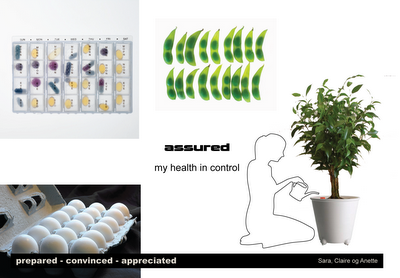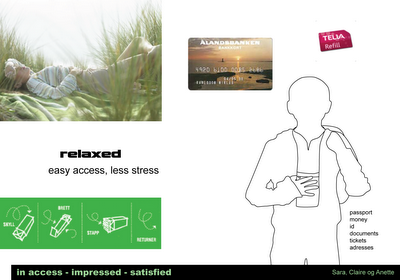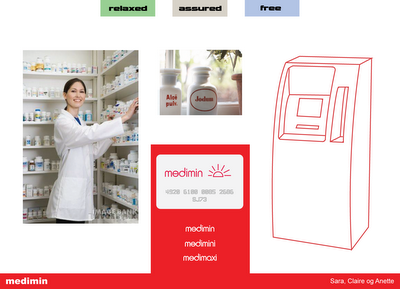Monday, October 23, 2006
Saturday, October 21, 2006
 The final concept Medimin - the card and the machine at the pharmacies. The same concept could also be implemented just as a journal card system, without the machines. That would be both easier and cheaper to apply on the existing system..
The final concept Medimin - the card and the machine at the pharmacies. The same concept could also be implemented just as a journal card system, without the machines. That would be both easier and cheaper to apply on the existing system.. The touchpoints in the service combined with the main emotions for each one of them.
The touchpoints in the service combined with the main emotions for each one of them. Freedom is something that appears when you are relaxed and assured. There was a discussion of if the definition should be in control instead, and that might be more suitable as well.
Freedom is something that appears when you are relaxed and assured. There was a discussion of if the definition should be in control instead, and that might be more suitable as well.Anyway, the superior feeling of being in control should be freedom; freedom to come and go as you like, metaphorically compared to travelling with a light cabin bag - no need to check in your luggage - just of you go..
 Assured as in that youl feel that you have control over your own health. At the same time it should give you the impression of that someone's looking after you (your doctor or the system in general). When you need a refusion to a specialist, or when you need a new prescription this could be automatically updated to your card when you swipe it at the pharmacy. If you have prescriptions for chronical conditions there could be a service with reminders on sms.
Assured as in that youl feel that you have control over your own health. At the same time it should give you the impression of that someone's looking after you (your doctor or the system in general). When you need a refusion to a specialist, or when you need a new prescription this could be automatically updated to your card when you swipe it at the pharmacy. If you have prescriptions for chronical conditions there could be a service with reminders on sms.The medicine-machine at the pharmacies could also help people who need it, particulary old people, to organize their medicins in daily doses.
 Relaxed - the card should give an association to the travel bag kids sometimes wear around their neck when travelling; keeping track of all documents you need, like passport, ticket, phonebook, money..
Relaxed - the card should give an association to the travel bag kids sometimes wear around their neck when travelling; keeping track of all documents you need, like passport, ticket, phonebook, money..
First out is one concept that appeared through touchpoint cross pollination. It is an combination of a prescription and an automat. This automat could be placed at pharmacies, and your own access should be through a card that work as a journal to give you control over your medical history. We work with words, pictures and metaphors to describe the emotions in the concept.
Emotions
Most business professionals of various backgrounds find it hard to relate to emotions directly connected to their working field. They often seek designers help to analyse, understand and describe emotions related to products as well as services. Therefore it is of great importance that designers are able to work professionally with the emotional dimension in a development process.
Emotional experiences can be designed for a specific service touch point or choreographed as an experience through several encounters with several service touch points (experience flow).
We take two of our earlier concepts that we think has development potential; one of them more radical than the other, and focus especially on the emotional experience in the chosen service concept.

With MedTV we combine the health center with a reality show of the more sober type. MedTV should show the daily life on the health center. The gain of this arrangement ould be a teaching aspect for other patients who watch TV, and the appointments might be subsidized with the commercial income of the show. The patients would of course be aware of the special conditions at this particular health center, that their appointment might hit the screen. Maybe this might be their own 15 minutes of fame, or as an alternative they could choose to be anonymous.

Another idéa of ours is to combine religion and health. Faith can be an iportant part of the healing of the body, more pragmatically referred to as the placebo effect. One aspect is to simply incorporate a sacred type of architecture in the physical appearance af the health centers. We also discuss if the local church's natural centerpoint in society (historically) could be adapted by the health centers - a place to gather, to worship, to focus on health - to create a preventive effect. Maybe the catholic confession could act as a model for the patients appointment with his doctor?
We discuss if we need something to believe in in this health religion and stumble upon quant medicine (also called energy medicine) as an interresting option. This is basically communication through different frequences with the body on a cellular level, to discover different types of imbalance and illness in an early stage. The use of this type of technological equipment is already in use as a diagnosis tool in hospitals, so this could be a supplement to the meeting with the doctor at the "confession". Quant medicine equipment visalizes your health status on a computer screen. If the effects of how you treat your body were more visible to you as a patient, maybe this could affect your life style..?
Friday, October 20, 2006

During the intro to the task by two different doctors it gets clear to us that there is a big patient segment who contact their GP almost without ny obvious reason. They are not really sick, maybe they are old, lonely, sometimes hypocondric, or just anxious - looking for their doctor, with the authoroty that follows his occupation, to confirm that they are doing fine. The public therapeutic offering through psychologists and psychiatrists are decreasing, and at the same time there seem to be a big need for this aspect on health in society. Why not create a new occupation - a mixed breed of a medical doctor and a psychologist. Doctor means teacher in latin so we chose ADIUTOR (that means guide in latin) as the name on this new direction.

This is the competition landscape, as we see it, in health care today. In the "center" of this net we place the GP's office, besides that this is central in the designbrief this is also the first contact place for most patients when they need to check up on their health status. Some of the internal connections between the actors are marked out as well.
Tuesday, October 10, 2006


What is the doctor's core competence? We try to get to the piont with the five why method, asking ourselves why the doctor himself started his carreer in medicin in the first place. The conclusion is a diagram of the the two core user's interests of the medical service; the doctor and the patient might have a slightly different perspective in this matter, mainly because the doctor has to deal with reputation and status both among colleagues and patients.
Offerings
"The core of all service provision is the offering that they deliver to their users. In reality this is a mix of primary (core) and secondary offerings. The core offering is often the reason a company exists and is central in the service provider’s strategies, brand, employee competences, infrastructure and its touch-points. In other words, it forms the so-called company DNA."
To design the optimal offering for the customer we need to understand the context or market space that the company is operating within. This requires the careful consideration of the three elements core competence, time spirit (zeitgeist) and the competition landscape; to investigate whether there is a need of this service and to find out where we can find a way to fill the gap between existing offerings.


